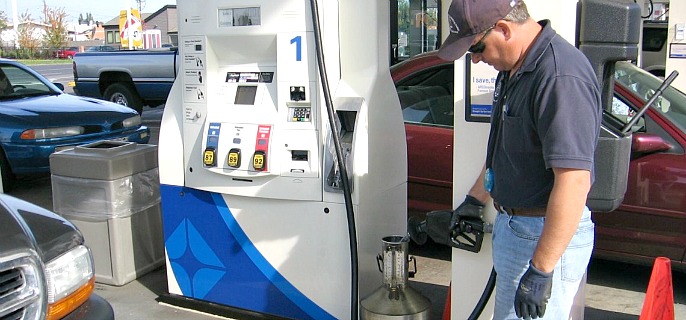
PHOTO COURTESY OF ODA
Motorists in Oregon should generally feel confident they are getting good gasoline and diesel, based on statistics for 2016.
Routine inspections by the Oregon Department of Agriculture this past year, along with ODA responses to consumer complaints, indicate a very limited amount of problems. That means, on the whole, drivers are getting what they pay for when they pull up to the pump at service stations throughout the state.
The year end report card shows Oregon’s motor fuel with an “A-plus” rating.
“Consumers can feel assured about the quality of the motor fuel they purchase in Oregon” says Steven Harrington, deputy administrator of ODA’s Weights and Measures Program. “Overall, the quality of gasoline sold in Oregon appears to be very, very good and motorists are not likely to experience problems associated with motor fuels sold in the state.”
ODA’s 18 Weights and Measures field inspectors conduct annual fuel quality inspections nearly everywhere motor fuels are sold in Oregon. Inspectors check motor fuel at the pump for various quality standards including purity, visual clarity, octane ratings, and biofuel content. In addition, Oregon’s renewable fuel standard requires that, with a few exceptions, gasoline contains a 10 percent ethanol and diesel contains at least 5 percent biodiesel. ODA inspectors make sure those requirements are being met.
In 2016, ODA inspectors conducted 1,950 screenings of gasoline and diesel taken from nearly 30,000 Oregon fuel dispensers located at some 2,100 businesses throughout the state. The samples are routinely checked both for their octane rating and for visible contamination.
“When it comes to octane, premium gasoline is where we would expect to find problems if there are any,” says Harrington. “Last year, we screened 757 premium gasoline samples and found no significant issues with the octane posting on the pump.”
According to Harrington, there are a couple of obvious ways for a retailer to commit fraud in the gasoline market. An operator can over-order on their regular gasoline and ask that the tanker driver deliver the remainder in the premium gasoline tank, or an operator can tamper with the blending settings on their fuel dispensers. The consumer doesn’t have any way to verify the octane posting of the gasoline at the time of purchase. Motorists rely on ODA to conduct routine inspections of the fuel and to follow up on complaints when fuel quality issues are suspected.
In 2016, ODA responded to 18 consumer complaints, which are often generated when a vehicle breaks down leaving the owner with a potentially expensive repair bill. When the mechanic informs the vehicle owner that bad gas was the culprit, ODA is able to respond and help determine if the fuel was really the problem.
“We’ve investigated fuel complaints where the repair bill was a few hundred dollars to over $10,000 in one case,” says Harrington. “The three most common fuel quality issues that send a vehicle to the repair shop are water, sediment, and tanker delivery errors. Every once in awhile a load of diesel fuel from a tanker truck will end up in a gasoline storage tank. When we find contaminated fuel, we will hold it off sale until the owner proves that the fuel has been brought back into specification as is required by Oregon law. It’s rare when this happens but its really frustrating for vehicle owners when it happens to them. If a consumer suspects they might be the victim of bad gasoline, they can turn to ODA to try and get answers.”
ODA inspectors regularly measure the amount of water in storage tanks to make sure it does not exceed state standards, using a stick with a water finding paste that turns pink upon contact with water. Any amount exceeding the standards requires the service station owner to remove the excess water so that it doesn’t end up in the consumer’s gas tank.
“Water is a concern for owners of underground storage tanks,” says Harrington. “All it takes is one leak anywhere in the system for rainwater or snowmelt to contaminate the fuel inside. ODA’s inspectors can issue off sale orders when the risk of passing that water on to the consumer is high.”
Last year, ODA screened 4,700 storage tanks. Those screenings showed 130 tanks having measurable water and 21 in excess of the tolerance.








